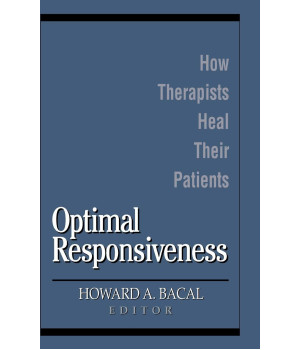Optimal Responsiveness: How Therapists Heal Their Patients
SKU: DADAX0765701146
ISBN : 9780765701145
Condition : New
Shipping & Tax will be calculated at Checkout.
US Delivery Time: 3-5 Business Days.
Outside US Delivery Time: 8-12 Business Days.
Optimal Responsiveness: How Therapists Heal Their Patients
ReviewBacal turns our older shibboleths on their heads and comes up with a new psychotherapeutic model in his summation of the post-modern trajectory of self psychology, intersubjectivity, and relationalism. If optimal frustration was the principal feature of the clinical approach in the hey-day of drive theory, facilitation significantly extends our therapeutic reach in a more positive, humanistic direction. Optimal responsiveness epitomizes a turning point in how we understand and conduct psychotherapy today and supplies the overarching human dimension to a technique that has become mechanical, its sterility obvious. Bacal and his contributors challenge and relieve us at the same time. -- James S. Grotstein, M.D.What, at heart, is it that heals in psychoanalytic therapy? Therapeutic change stems not from such negative strictures as analytic anonymity, neutrality, or basic frustration emphasized in the classical tradition, but rather from the positive aspects of the experience of intersubjectivity between patient and therapist working with feelings honestly together. Bacal authoritatively sets the stage, and then each of his seventeen colleagues, all leading self-psychologists, engages about one aspect of the technique such as sharing, enactments, or management of disruption. Nowhere else has this theory been put together so comprehensively. With plenty of good clinical material, the book is inspiring and unputdownable. -- Eric Rayner, Ph.D.The term optimal responsiveness, like Oedipus complex, primal scene, and selfobject, has great evocative power. The reader is helped to follow the multifaceted discourse, which begins at the core of the two-person clinical exchange, by Bacal's careful grouping of papers and his easily comprehended introductions. The book retains its intimate connection to the question of what helps people (patients and therapists), and the reader comes away with a sense of the profound evolution of the psychoanalytic approach and our understanding of it over the last quarter century. Intellectually stimulating and extremely useful to the practicing professional. -- Joseph D. Lichtenberg, M.D.Bacal's concept of optimal responsiveness provides a powerful lens to assist us in rethinking the analyst's role in the therapeutic process, which has moved from a one-person model to one of mutual influence. Outstanding contributors elucidate their listening and experiencing perspectives and their views of transference and empathy, among other issues, to help us reassess what we as therapists do to facilitate our patients' development. -- Peter Lessem, Ph.D.Optimal Responsiveness is about the therapeutic process-what it is that actually heals patients. The answer that emerges is that the specificity of fit between the understanding and response a patient needs and a therapist can provide is central to effecting change. This is a gold mine of clinical wisdom that stands at the leading edge of our expanding knowledge; it illuminates and richly illustrates the relation-systems view of therapeutic transformation. -- Robert D. Stolorow, Ph.D.A new generation of dynamic therapists is taking a fresh look at what actually heals the patient. In contrast to the classical vision, whose essential feature is intervention by interpretation in an ambience of optimal frustration, Bacal's conception of optimal responsiveness legitimizes a whole repertoire of professional behaviors-empathic attunement, confrontation, support, self-disclosure, validation or invalidation.Everything the therapist does or does not do, does or does not say, is experienced by the patient as some kind of response. Because the relational dynamic is unique to each therapist-patient dyad, the therapist's responses can be tailored to meet the patient's needs, enhancing specificity. And because optimal responsiveness implies recognition of the therapeutic process as a reciprocal system, it also implies reconstrual of what we know
Specification of Optimal Responsiveness: How Therapists Heal Their Patients
| GENERAL | |
|---|---|
| Author | Bacal, Howard A. |
| Binding | hardcover |
| Language | english |
| Edition | First Edition |
| ISBN-10 | 765701146 |
| ISBN-13 | 9780765701145 |
| Publisher | Jason Aronson, Inc. |
| Publication Year | 01-04-1998 |
Write a review
Your Name:
Your Email:
Your Review:
Note: HTML is not translated!
Rating: Bad Good
Enter the code in the box below:



